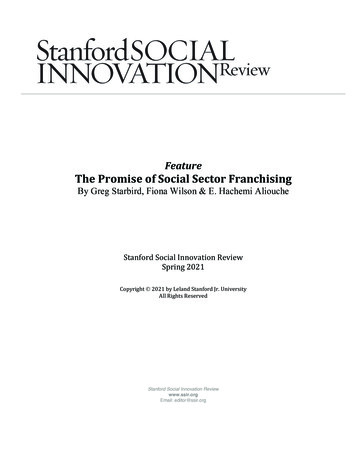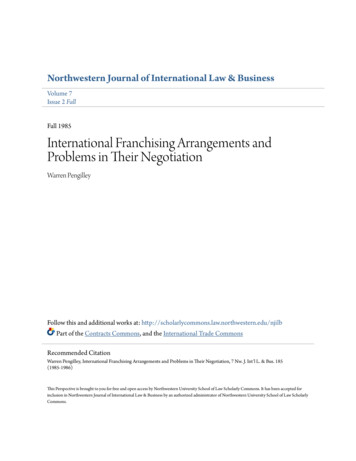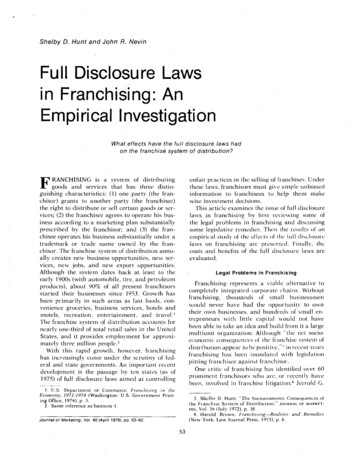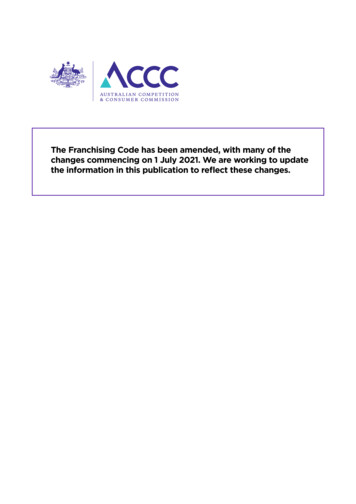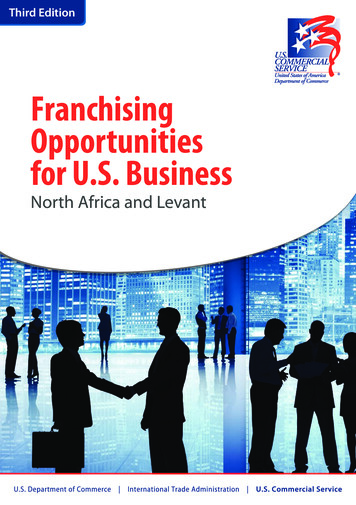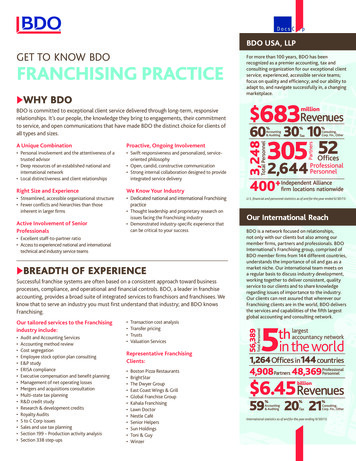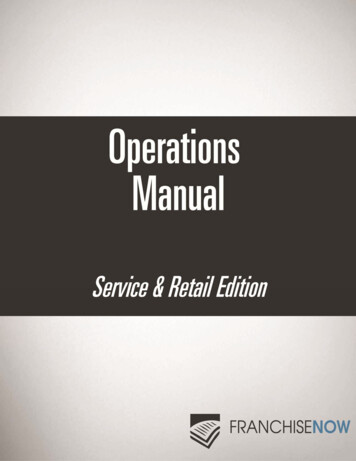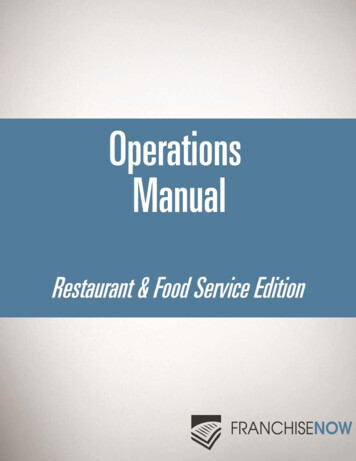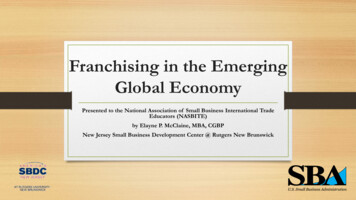
Transcription
Franchising in the EmergingGlobal EconomyPresented to the National Association of Small Business International TradeEducators (NASBITE)by Elayne P. McClaine, MBA, CGBPNew Jersey Small Business Development Center @ Rutgers New Brunswick
Elayne P. McClaine, MBA, CGBPRegional Director, NJSBDC-NB Elayne P. McClaine is Regional Director for the New Jersey Small Business DevelopmentCenter at Rutgers New Brunswick. She has been involved with the SBDC since 2005 invarious roles such as Lead Client Counselor, Instructor, and Assistant Director. She hasextensive expertise in the areas of Business & Strategic Planning; Business FinancialManagement; Market Research; Business Valuation & Franchising. She is a Certified GlobalBusiness Professional (CGBP), an Accredited Business Planning Advisor and a CertifiedGrowthWheel Advisor. She is an SBA and SBDC Global Counselor and Instructor. Prior to joining the SBDC, Ms. McClaine accomplished over 20 years of BrandManagement--both domestically and globally—ranging from SMEs to Fortune 100 firms.She also has extensive experience as a Business Broker and Management Consultant. Elaynehas an MBA-Finance from Regis University and a BA-Economics from Fordham University.
Understanding the Global Consumer:95% of The World’s Consumers Live OutsideUnited States By 2025, more than half of the world’s population will have joined the consumer class. Thiswill drive annual consumption in emerging markets to 30 Trillion. McKinsey, 2012 Almost half of the world’s GDP Growth between 2010 and 2015 will come from 440 Cities inemerging markets By 2025, 45% of businesses on Fortunes Global 500 listwill be based in emerging markets compared to just 5% in 2000. Cross-Border eCommerce is predicted to triple by 2018, with130 million "major market" shoppers accounting for 307 billionin cross-border purchases--and that's only from the U.S., U.K.,Germany, Brazil, China and Australia.
Three Characteristics of an Emerging Market Level of Economic Development Typically measured by GDP per capita Economic Growth Rates exceeding 5%GDP Growth greater than Population Growth Market Governance Extent of free marketGovernment control of key resources (Red Tape, Bribery, Ownership Restrictions, Import Restrictions, capital flows, etc.)Stability of Market SystemRegulatory Environment
Developed vs. Emerging MarketsDeveloped MarketsEmerging MarketsGlobal PositionNorth and WestSouth and EastMarketing OrientationMarketing DevelopmentMarket ChannelMarketing OrientationConsumption EmphasisUnified and IntegratedSales OrientationProduction EmphasisFragmentedCulture and SocietyFormal, Contract Based, DirectCommunication, IndividualisticInformal, Relationship Based,Indirect al Understanding, DisputesSettled Contractually-Binding-Mutual Understanding, DisputesSettled by Negotiation-Flexible
Rationale for Global Expansion via Franchising International franchising is a strategic way to reduce dependence on domestic demandand grow new, future revenue and profit centers worldwide. Extending a brand globally through franchising involves a low risk, requires minimalinvestment and offers a huge upside potential on scaling capabilities. Franchise businesses around the world have seen steady growth in the past decade,particularly in Brazil, China and Mexico. According to the IFA, their members are eyeingoverseas expansion as an important way to diversify their portfolios. Over 60% of IFA members currently franchise or operate in international locations, and16 percent generate between 25 percent and 30 percent of revenue from internationalactivities. Top 200 Franchisors now have 36% of their units outside of United States
Rationale for Global Expansionvia Franchising for Small Business According to the International Trade Administration, 281,668 businesses with fewer than 500 employeesexported from the United States in 2008, accounting for 97.5 percent of all U.S. exporters. Minority firms are specially attracted to global expansion and Franchising:
The Pros and Cons ofInternational Franchising Opportunities New Revenue SourcesGrow Stakeholder ValueLess Competitive and Regulated marketsLeverage Existing IPAttract Investment to Grow the Brand Challenges Choosing Countries with the Best ROIfor your Business Finding the Right Licensee Diminishing focus on DomesticBusiness High Staff, analysis and travel start upcosts Excessive Due Diligence Supply Chain Management
The Pros and Cons of InternationalFranchising in Emerging Markets Among the general characteristics of emerging markets are: Low GNP, but high potential growth Unequal distribution of income, but a growing middle class Limited but growing consumerism Lack of managerial and entrepreneurial talent Lack of capital for economic international franchising expansion Political instability Undeveloped infrastructure High cost of transaction and agency costs-
Factors to Consider When Selecting CountriesCountry StabilityViable Consumer MarketIntellectual Property ProtectionRule of LawGood GDP Growth IndicatorsPotential to Generate Adequate Profit and ROI
Franchisor Must Have These Qualities A Brand that will attract Demand globally Excellent Business Model in their current country Strong, replicable unit franchise results Proven Margins in a competitive environment Consistent growth based on repeat customers not market stimulation Strong training, support, marketing and Internet Resources Financial model that offers licenses the potential for a consistent ROI
In-Country Franchisee Partner Must HaveThese Qualities Clear understanding of your businessGood business reputation and connections in-countrySuccessful knowledge of the industry and sectorSuccessful knowledge of cultural moresAccess to suitable real estateAdequate capital to grow your franchise in-countryExperienced management to put into the franchise
NTVENTUREDIRECT UNITFRANCHISEmoreCONTROLless
Direct UnitFranchisingPros Control: Franchisor is able to retain control Revenue: No Sharing of the royalty stream Testing Markets: Franchisor can validate one unit at atime Tiered Expansion: Minimal RiskCons Limits on Growth Rate: Few franchises at a time Lower Fees: In line with slower growth, lower fees inshort term Increased Due Diligence and Research: Franchisortotally responsible Capital Resources and Time: Franchisor Managesfranchises and expansion—costs, legal risks, compliance Disclosure Laws: Franchisor must comply with all locallaws Taxes: Reporting and payment obligations; Franchiseemay be required to withhold on amounts paid toFranchisor Exposure: Local laws may favor franchises
Joint VenturePros Ownership and Control: Allows Franchisor tomaintain actual ownership over expansion andoperations while requiring foreign partner toinvest the most resources and capital Flexibility: Can be Master Franchise or AreaDevelopment Model Tax Benefits: Entity may be eligible for taxbenefits or incentives available to “permanentestablishments” in the foreign market Potential Greater Share of JV’s Profits:Franchisor may also receive greaterroyalties/license payments and profits viadividends and distributionsCons Potential for Loss of Control: Local partnermay be a “partner and have more say in operationsand expansion Exposure: Franchisor may be exposed to moreliability stemming from laws of foreign marketsfranchise laws, general, corporate law and taxes,and ownership structure Disclosure Laws: Franchisor must comply withall local laws. Prolonged Negotiations: Negotiating the termsof the JV Partnership may involve complex issues
Area LicensePros Same as Direct Franchising Upfront Capital Infusion: Franchisor will receive an upfrontpayment with creation of area development agreement with thedeveloper—may also mean deferred or reduced royalties Leverage Local Knowledge and Expertise: Franchisor willbenefit from developers knowledge of local market conditions,culture, political, legal and economic issues Administrative Ease of Termination: Easier to terminateand/or replace an area development agreement within a specifiedterritory as compared to a master franchise agreementControl: Entering into unit franchise agreements in addition toarea development agreement provides franchisor with controlover growth and operationCons Same as Direct Franchising Local Disclosure Laws: Franchisor must comply with all localobligations to supply a disclosure document for not only thedevelopment agreement but also each unit franchise agreementwhich may be a financial and administrative burdenConstrained by Capital Resource of Developer: Growth ofFranchisor’s Brand and system in foreign market will be limited byfunds available. Franchisor reliant upon developer’s track recordand financial position
ProsMasterFranchisor Fast Avenue to Growth: Fast path to growing Franchisor’s Brand and system inforeign Market Risk Management: Master Franchisee will bear the larger risk of loss and legal risksas it is the party contributing the majority of capital, HR resources and recruitment Cons Unrealistic Development Schedules Territory: Franchisors must be mindful of granting too large a territory to a MasterFranchisee who cannot adequately service. Smaller territory with first right of refusalwould be better optionLeverage Local Knowledge and Expertise: Franchisor will benefit from themaster franchisee’s knowledge of local market conditions, culture, political, legal andeconomic conditions Risks from Heightened Reliance on Master Franchises: This model can give riseto the downside risk of connecting with the wrong local partner. Poor choices cannegatively impact brand and goodwill Reduced Investment of Franchisors Time and Resources: Less time, capital andhuman resources are required from Franchisor Economies of Scale for Sub-franchisees: Franchisor can scale up franchiseoperations quickly, master franchisee can pass on efficiencies to sub-franchiseeshelping them to operate profitablyRisks for Future Re-Entry to Market: If the Master Franchisee is unsuccessful orcannot deliver expansion goals, it will be difficult for the Franchisor to re-enter with afailed brand. Upfront Capital Infusion for Franchisor: Non-Refundable fee paid at outsetUnavailable in Certain Markets: Certain jurisdictions will not permit a Franchisorto enter into a Master Franchisee agreement without “ownership or “skin in thegame” Disclosure Laws: The Master Franchisee, not the Franchisor would be responsiblefor complying with disclosure laws Failure to Handle Pilot Units and Administration of System: Master Franchiseemay fail as a result of inability to focus on pilot operations and administration whichrequires legal and regulatory expertise Liability to Sub-franchisees: Franchisors can be insulated from liability by limitingdirect involvement and contracts Disclosure Laws: Franchisor may still be required to comply with respect to thegrant of the Master Franchisee. Liability to Sub-franchisees: Franchisors cannot assume that lack of contractualinclusion will exempt them from local laws and franchisee recourse
International Multi-UnitFranchise AgreementPros Reduced Administrative Burden and Costs: Less time and capital andhuman resources required once an IMUFA is executed Fast Avenue to Growth: As administrative burdens are reduced, resourcescan be placed towards the growth and expansion plan Cons Loss of Control: Compared to the development agreement model, theFranchisor has less control over individual franchise outlets once the IMUFAis executed. Leverage Local Knowledge and Expertise: Franchisor will benefit fromlocal partner’s knowledge of local market conditions, culture, political, legaland economic conditionsUnrealistic Development Schedule: Difficult to set realistic, rather thanoverly aggressive development schedules, especially upfront. Economies of Scale for Franchisees: By scaling up franchise operationsquickly, economics can be passed onto unit franchisees helping them tooperate more efficiently and profitablyUpfront Heavy Lifting: Significant foresight and heavy investing in initialdrafting is required to consider how the franchise relationship will begoverned over time. Upfront Capital Infusion for Franchisor: Generally a large non-refundablemaster franchise fee is paid to Franchisor at outset of the relationshipForms of Agreement: Unlike area development model developers typicallyagree to open outlets signing them at then current form of franchiseeagreement. Since all rights are granted up front in the IMUFA, there is noopportunity for the Franchisor to require new outlets to be operated pursuantto the then current agreement. Disclosure Laws: The Franchisor may still be required to comply withdisclosure laws with respect to the grant of the IMUFA. If the Franchisorhas not previously granted an IMUFA, it will have to undertake the cost andexpense of dong so as part of its first expansion.
Co-BrandingPros Concept especially designed for Small Business: Lowinvestment level on two or more franchises that arerelated—may be matched with a local franchisee, i.e. agas station Leverage Local Knowledge and Expertise:Franchisor will benefit from local partner’s knowledgeof local market conditions, culture, political, legal andeconomic conditions. Economies of Scale for Franchisees: Lower overheadand operating costs. Shared space, equipment and crosstrained employees. Leverages complimentary orcompatible brands or concepts in a single location Diversifying Risk: Expanded customer base under oneroof. Reduced investment and operating cost.Cons Limits on Growth Rate: Match and opportunity maytake time Increased Due Diligence and Research: Franchisortotally responsible Capital Resources and Time: Franchisor Managesfranchises and expansion—costs, legal risks, compliance Disclosure Laws: Franchisor must comply with all locallaws Taxes: Reporting and payment obligations; Franchiseemay be required to withhold on amounts paid toFranchisor Exposure: Local laws may favor franchisees
Small Business Impact Global expansion impacts small businesses both domestically and abroad Contributes to company growth, expansion and profitabilityImproves competitive stance for brand and for businessStrengthens local economic developmentGenerates lending and funding impactIncreases jobGlobal marketplace access via Internet supports domesticsales and growthSmall Franchisor can capitalize on native country/regional connections
Small Business Impact US and SBA Global Support for Small Business Franchising SBDC and NASBITE CGBP Consultants SBA Franchise Registry 7(A) International Trade Loan Program Export Working Capital Program SBA Export Express Resumption of Exim Bank
For A Free ConsultationElayne P. McClaine, Regional DirectorNew Jersey Small Business Development Center at Rutgers New BrunswickLivingston CampusRutgers Business School 94 Rockafeller Road, Piscataway, NJ 08854Office: 848-445-8790 Direct: 848-445-8788Fax: nbRequest for Counseling, Calendar and Evaluation Forms
via Franchising for Small Business According to the International Trade Administration, 281,668 businesses with fewer than 500 employees exported from the United States in 2008, accounting for 97.5 percent of all U.S. exporters. Minority firms are specially attrac
